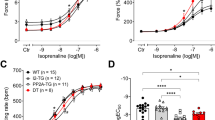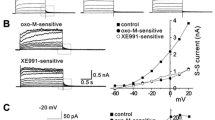Abstract
Acetylcholine decreases currents through cardiac L-type Ca2+ channels after stimulation with agents which elevate levels of cyclic adenosine monophosphate, such as isoproterenol, but there is still a controversy over the mechnisms of this muscarinic effect. We tested the hypothesis of whether, after isoproterenol stimulation, protein phosphatases are activated by acetylcholine. Whole-cell currents were recorded from guinea-pig ventricular myocytes. The effect of 10−5 M acetylcholine on currents induced by 10−8 M isoproterenol was studied in the absence or presence of protein phosphatase inhibitors. Three agents reduced the acetylcholine response: okadaic acid (3 or 9 · 10−6 M) and cantharidin (3 · 10−6 M) added to the pipette solution, and bath-applied fluoride (3 mM). In contrast, pipette application of other phosphatase inhibitors, namely the inhibitor PPI2 (1000 U/ml), ciclosporin (10−5 M), or calyculin A (10−6 M) did not significantly diminish the acetylcholine effect. Interestingly, there was no correlation between the effects of the compounds on basal Ca2+ current and their interference with the muscarinic response. An activation of type 2A phosphatases by acetylcholine would explain these findings. Indeed, okadaic acid is 3 orders of magnitude more potent in vitro in its inhibition of this isoform (purified from cardiac myocytes) than is calyculin A, while type-1 phosphatases are inhibited equally. The data support the attractive possibility that stimulation of protein phosphatases is part of the signal transduction cascade of Ca2+ channel inhibition by acetyl-choline.
Similar content being viewed by others
References
Ahmad Z, Green FJ, Subuhi HS, Watanabe AM (1989) Autonomic regulation of type 1 protein phosphatase in cardiac muscle. J Biol Chem 264:3859–3863
Balke CW, Wier WG (1992) Modulation of L-type calcium channels by sodium ions. Proc Natl Acad Sci USA 89:4417–4421
Cohen P (1989) The structure and regulation of protein phosphatases. Annu Rev Biochem 58:453–508
England PJ (1976) Studies on the phosphorylation of the inhibitory subunit of troponin during modification of contraction in perfused rat heart. Biochem J 160:295–304
Erdodi F, Csortos C, Bot G, Gergely P (1985) Separation of rabbit liver latent and spontaneously active phosphorylase phosphatases by chromatography on heparin-sepharose. Biochem Biophys Res Commun 128:705–712
Fischmeister R, Shrier A (1989) Interactive effects of isoprenaline, forskolin and acetylcholine on Ca2+ current in frog ventricular myocytes. J Physiol (Lond) 417:213–239
Fleming JW, Strawbridge RA, Watanabe AM (1987) Muscarinic receptor regulation of cardiac adenylate cyclase activity. J Mol Cell Cardiol 19:47–61
Frace AM, Hartzell HC (1993) Opposite effects of phosphatase inhibitors on L-type calcium and delayed rectifier currents in frog cardiac myocytes. J Physiol (Lond) 472:305–326
Gupta RC, Neumann J, Watanabe AM (1993) Comparison of adenosine and muscarinic receptor-mediated effects on protein phosphatase inhibitor-1 activity in the heart. J Pharmacol Exp Ther 266:16–22
Gupta RC, Neumann J, Boknik P, Watanabe AM (1994) M2-specific muscarinic cholinergic receptor-mediated inhibition of cardiac regulatory protein phosphorylation. Am J Physiol 266:H1138-H1144
Hartzell HC (1988) Regulation of cardiac ion channels by catecholamines, acetylcholine, and second messenger systems. Prog Biophys Mol Biol 52:165–247
Hartzell HC (1993) Filling the gaps in Ca2+ channel regulation. Biophys J 65:1358–1359
Herzig S, Patil P, Neumann J, Staschen CM, Yue DT (1993) Mechanisms ofβ-adrenergic stimulation of cardiac Ca2+ channels revealed by discrete-time Markov analysis of slow gating. Biophys J 65:1599–1612
Hescheler J, Kameyama M, Trautwein W (1986) On the mechanism of muscarinic inhibition of the cardiac Ca current. Pflügers Arch 407:182–189
Hescheler J, Kameyama M, Trautwein W, Mieskes G, Söling HD (1987) Regulation of the cardiac calcium channel by protein phosphatases. Eur J Biochem 165:261–266
Hescheler J, Mieskes G, Rüegg JC, Takai A, Trautwein W (1988) Effects of a protein phosphatase inhibitor, okadaic acid, on membrane currents of isolated guinea-pig cardiac myocytes. Pflügers Arch 412:248–252
Honkanen RE (1993) Cantharidin, another natural toxin that inhibits the activity of serine/threonine protein phosphatases types 1 and 2A. FEBS Lett 330:283–286
Hu SJ, Inselmann G, Mohr K, Nellessen U (1993) Lack of inotropic effect of ciclosporin A in isolated guinea pig left atria. Cardiovasc Res 27:172–175
Ishihara H, Martin SL, Brautigan DL, Karaji H, Ozaki H, Kato Y, Fusetani N, Watabe S, Hashimoto K, Uemura D, Hartshorne DJ (1989) Calyculin A and okadaic acid: Inhibitors of protein phosphatase activity. Biochem Biophys Res Commun 159:871–877
Kohl C, Schmitz W, Scholz H (1990) Positive inotropic effect of carbachol and inositol phosphate levels in mammalian atria after pretreatment with pertussis toxin. J Pharmacol Exp Ther 254:894–899
Kohl C, Linck B, Schmitz W, Scholz H, Scholz J, Toth M (1991) Effects of carbachol and (-)N6-phenylisopropyladenosine on myocardial inositol phosphate content and force of contraction. Br J Pharmacol 101:829–834
Koumi SI, Ten Eick RE, Wasserstrom JA (1993) Direct activation of protein phosphatase by the α-subunit of a muscarinic receptor-coupled G protein modulates cardiac inwardly-rectifying K+ channels (abstract). Circulation 88:I232
Levi RC, Alloati G, Penna C, Gallo MP (1994) Guanylate-cyclase-mediated inhibition of cardiac ICa by carbachol and sodium nitroprusside. Pflügers Arch 426:419–426
Li YM, Casida JE (1992) Cantharidin binding protein: identification as protein phosphatase 2A. Proc Natl Acad Sci USA 89:11867–11870
Li YM, Mackintosh C, Casida JE (1993) Protein phosphatase 2A and its [3H]cantharidin/[3H]endothall thioanhydride binding site. Inhibitor specificity of cantharidin and ATP analogues. Biochem Pharmacol 46:1435–1443
Liu J, Farmer JD, Lane WS, Friedmann J, Weisman J, Schreiber SL (1991) Calcineurin is a common target of ciclosporin A and FKBP-FK 506 complexes. Cell 66:805–817
Löffelholz K, Pappano AJ (1985) The parasympathetic neuro-effector junction of the heart. Pharmacol Rev 37:1–24
Lohmann SM, Fischmeister R, Walter U (1991) Signal transduction by cGMP in the heart. Basic Res Cardiol 86:503–514
Manalan AS, Werth DK (1987) Cardiac calmodulin-stimulated protein phosphatase: purification and identification of specific sarcolemmal substrates. Circ Res 60: 602–611
Marks WH, Harding MW, Handschumacher R, Marks C, Lorber MI (1991) The immunochemical distribution of cyclophilin in normal mammalian tissues. Transplantation 52:340–345
Mery PF, Lohmann SM, Walter U, Fischmeister R (1991) Ca2+ current is regulated by cyclic-GMP-dependent protein kinase in mammalian cardiac cells. Proc Natl Acad Sci USA 88:1197–1201
Mery PF, Pavoine C, Belhassen L, Pecker F, Fischmeister R (1993) Nitric oxide regulates cardiac Ca2+ current. Involvement of cGMP-inhibited and cGMP-stimulated phosphodiesterases through guanylyl cyclase stimulation. J Biol Chem 268:26286–26295
Mumby MC, Walter G (1993) Protein serine/threonine phosphatases: structure, regulation, and functions in cell growth. Physiol Rev 73:673–699
Neumann J, Schmitz W, Scholz H, Stein B (1989) Effects of adenosine analogues on contractile response and cAMP content in guinea pig isolated ventricular myocytes. Naunyn-Schmiedebergs Arch Pharmacol 340:689–695
Neumann J, Gupta RC, Schmitz W, Scholz H, Nairn AC, Watanabe, AM (1991) Evidence for isoproterenol-induced phosphorylation of phosphatase inhibitor-1 in the intact heart. Circ Res 69:1450–1457
Neumann J, Boknik P, Herzig S, Schmitz W, Scholz H, Gupta RC, Watanabe AM (1993) Evidence for physiological functions of protein phosphatases in the heart: evaluation with okadaic acid. Am J Physiol 265:H257-H266
Neumann J, Boknik P, Kaspareit G, Schmitz W, Zimmermann W (1993) Activity of cardiac phosphatases in failing and non-failing human hearts (abstract). Naunyn-Schmiedebergs Arch Pharmacol 347:R84
Neumann J, Boknik P, Bodor GS, Jones LR, Schmitz W, Scholz H (1994) Effects of adenosine receptor and muscarinic cholinergic receptor agonists on cardiac protein phosphorylation. Influence of pertussis toxin. J Pharmacol Exp Ther 269:1310–1318
Neumann J, Boknik P, Herzig S, Schmitz W, Scholz H, Wiechen K, Zimmermann N (1994) Biochemical and electrophysiological mechanism of the positive inotropic effects of calyculin A, a protein phosphatase inhibitor. J Pharmacol Exp Ther (in press)
Obara K, Yabu H (1993) Dual effect of phosphatase inhibitors on calcium channels in intestinal smooth muscle cells. Am J Physiol 264:C296-C301
Oliva C, Cohen IS, Mathias RT (1988) Calculation of time constants for intracellular diffusion in whole cell patch clamp configuration. Biophys J 54:791–799
Ono K, Fozzard HA (1993) Two phosphatase sites on the Ca2+ channel affecting different kinetic functions. J Physiol (Lond) 470:73–84
Ray A, Macleod KM (1992) Role of cAMP in the functional interaction of carbachol with different cAMP elevating agents in rabbit atrium. Life Sci 51:1411–1418
Richardson RM, Kim C, Benovic JL, Hosey MM (1993) Phosphorylation and desensitization of human m2 muscarinic cholinergic receptors by two isofoms of theβ-adrenergic receptor kinase. J Biol Chem 268:13650–13656
Shenolikar S, Nairn AC (1991) Protein phosphatases: recent progress. Adv Second Messenger Phosphoprotein Res 23:1–121
Steiner JP, Dawson TM, Fotuhi M, Glatt CE, Snowman AM, Cohen N, Snyder SH (1992) High brain densities of the immunophilin FKBP colocalized with calcineurin. Nature 358:584–587
Watanabe AM, Besch HR (1975) Interaction between cyclic adenosine monophosphate and cyclic guanosine monophosphate in guinea pig ventricular myocardium. Circ Res 37:309–317
White RE, Lee AB, Shcherbatko AD, Lincoln DM, Schonbrunn A, Armstrong DL (1993) Potassium channel stimulation by atrial natriuretic peptides through cGMP-dependent dephosphorylation. Nature 361:263–266
Wiechen K, Herzig S (1993) Different effects of phosphorylation on single cardiac calcium channel gating are distinguished using specific protein phosphatase inhibitors (abstract). Naunyn-Schmiedebergs Arch Pharmacol 348:R173
Wiechen K, Yue DT, Herzig S (1995) Two distinct functional effects of protein phosphatase inhibitors on guinea-pig cardiac L-type Ca2+ channels. J Physiol [Lond] (in press)
Yatani A, Brown, AM (1991) Mechanism of fluoride activation of G protein-gated muscarinic K+ channels. J Biol Chem 266:22872–22877
Yue DT, Herzig S, Marban E (1990)β-Adrenergic stimulation of calcium channels occurs by potentiation of high-activity gating modes. Proc Natl Acad Sci USA 87:753–757
Zhang Z, Deans-Zirattu S, Browner MF, Lee EYC (1992) Expression of the catalytic subunit of phosphorylase phosphatase (protein phosphatase-1) in Escherichia coli. J Biol Chem 267:1484–1490
Zimmermann N, Gams E, Neumann J, Boknik P, Scholz H (1994) Effects of ciclosporin A on protein phosphorylation in the heart. Transplant Proc (in press)
Zwiller J, Ogasawara EM, Nakamoto SS, Boynton AL (1988) Stimulation by inositol trisphosphate and tetrakisphosphate of a protein phosphatase. Biochem Biophys Res Commun 155:767–772
Zwiller J, Revel MO, Boynton AL, Honkanen R, Vincendon G (1990) Phosphorylation of an inositol phosphate-stimulated protein phosphatase by protein kinase C. Biochem Int 20:967–977
Author information
Authors and Affiliations
Rights and permissions
About this article
Cite this article
Herzig, S., Meier, A., Pfeiffer, M. et al. Stimulation of protein phosphatases as a mechanism of the muscarinic-receptor-mediated inhibition of cardiac L-type Ca2+ channels. Pflügers Arch. 429, 531–538 (1995). https://doi.org/10.1007/BF00704158
Received:
Revised:
Accepted:
Issue Date:
DOI: https://doi.org/10.1007/BF00704158




